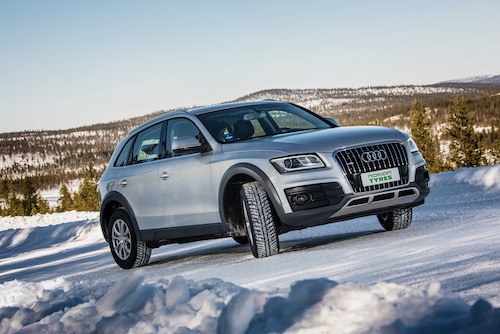Selecting your winter tyres isn’t that easy process and you will need to take time to ensure that you will get a set that are safe and that fit your vehicle. There are several options out there and if they are approved for winter use, you at least know what they have passed the test requirements for safe driving on ice, snow and slush. This is indicated by having the snowflake symbol on the sidewall of the tyres. This is different than the M+S marking that you might see on tyres and which used to be acceptable as winter tyres in some countries before. To be safe when driving in winter conditions you will need to have tyres that are winter approved, not just have a tread that can handle mud and snow.
When you select summer tyres, you have a lot of help by the EU tyre label. This will show you the safety of the tyres when it comes to wet grip, which is important for summer tyres. This indicates the braking distance on wet roads. Wet road conditions tend to be some of the most challenging conditions when you drive during spring, summer or autumn, as you will exclude all winter conditions that include snow, ice or slush. When you have very wet roads you also have the risk of aquaplaning. Aquaplaning is what happens when you get a layer of water between the tyre and the road surfaces. This is then caused be the tyres inability to push away the water that is on the road. A lot of development has been made in this area to improve the tyre’s ability to prevent aquaplaning from happening. Wider and polished grooves, sipes work together to both store water in the tread and push it to the sides.
The Eu tyre label also shows the rolling resistance of the tyres. The rolling resistance impacts both the fuel consumption and the wear rate of the tyres. Both these have an impact on the environment and the cost of driving your vehicle. So you should always strive to have tyres with low rolling resistance. Finally the Eu tyre label will show the rolling noise, which impacts the driving comfort. If you have an electric car the tyre noise can be disturbing but also for a sports car at high speeds.
When it comes to using the EU tyre label for winter tyres, you can see that it is missing information on how they perform on snow, ice and slush. Here it is better to then check tyre tests to get more information on how well they perform and how they compare to other tyres on the market.
Dimension to look for will depend on your vehicle. Passenger cars tend to have dimensions like, 205/55R16, so you can actually just search for 205/55R16 winter tyres to view what is available. If you have a sports car or a heavy SUV, you will have wider tyres than 205 mm.
For more information regarding how to best find good quality winter tyres, visit: https://www.nokiantyres.com/
